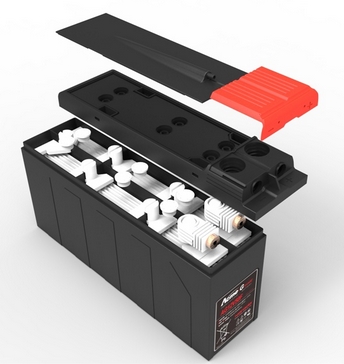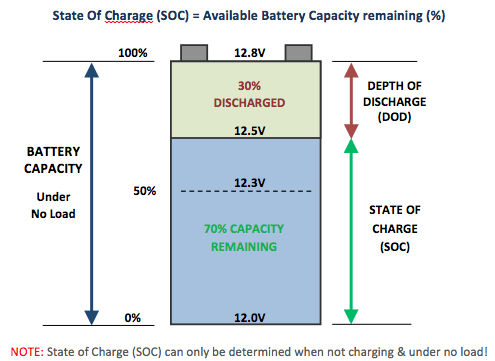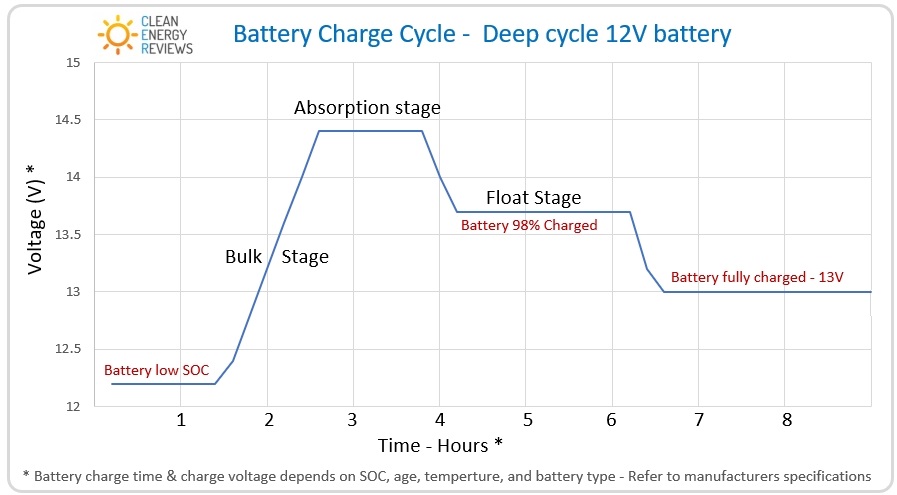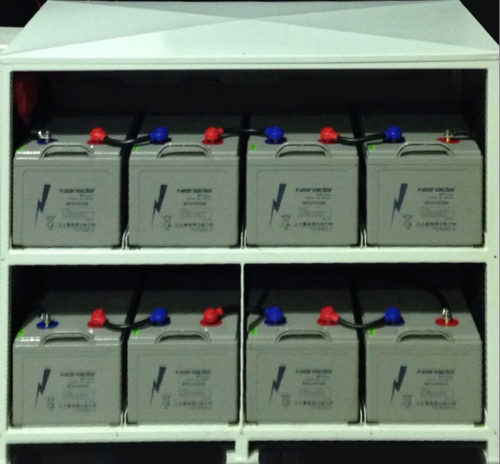Deep Cycle Batteries – Flooded, AGM, Gel & Lead Carbon
Until recently lead-acid deep cycle batteries were the most common battery used for solar off-grid and hybrid energy storage, as well as many other applications. Lead-acid batteries are available in a huge variety of different types and sizes and can be anything from a single cell (2V) battery or be made up of a number of cells linked together in series to operate at a required voltage. For example a common 12V battery (such as the one in your car) is actuallymade up of 6 x 2V cells in series. The most common battery voltages available are 2V, 6V and 12V.
There are several different types of lead-acid deep cycle batteries available with the four main varieties listed below:
The 4 Types Of Deep Cycle Lead-Acid Batteries
-
Flooded lead-acid (vented)
-
Valve regulated lead-acid (VRLA)
-
Absorbed glass mat (AGM)
-
Gel electrolyte (GEL)
-
-
Lead-carbon – Gel electrotyte
-
Deep cycle OPzV tubular gel
Valve Regulated Lead-Acid – VRLA
The oldest and most basic type is the flooded lead-acid battery where the electrolyte (acid) is in liquid form. Until 10-12 years ago flooded batteries were the most common deep cycle battery available and are still used for some large off-grid systems. During the charging and discharging of a flooded battery volatile gases are produced and are vented out of the battery to prevent the build-up of pressure. The disadvantage of this is that the electrolyte level is reduced and needs to be topped up regulary, however this also enables the battery to be maintained and thus flooded batteries can last a long time (up to 20 years or more) if regular maintenance is performed.
Sealed VRLA or valve regulated lead-acid batteries (AGM and Gel) work in the same way as a flooded battery but are sealed in a leak proof enclosure with the electrolyte in a non-liquid form.
VRLA batteries use a gas recombination system which combines the gases created during the charging/ discharging process back into the battery. This prevents almost all losses (close to 99%) of electrolyte through gassing. These batteries are thus non-serviceable or maintenance free as they are sealed and there is no chance of acid spillage. This means they are also much safer, easier to handle and transport than flooded batteries.

AGM Sealed lead-acid
Lead-carbon batteries are an advanced VRLA lead acid battery which use a common lead positive plate (anode) and a carbon composite negative plate (cathode). The carbon acts as a sort of ‘supercapacitor’ which allows faster charging and discharging, plus prolonged life at partial state of charge.
4. Tubular Gel OPzV Lead-Acid BatteriesMuch like the common Gel sealed batteries, lead-carbon batteries are also sealed and typically use a gel electrolyte for improved safety and low maintenance.
The REXC series Lead-Carbon batteries from Narada uses a nano carbon material cathode which the company claims also provides a much longer cycle life than traditional lead-acid batteries. There are several companies which manufacture lead-carbon batteries with nano carbon or advanced cathode alloy materials including Japanese manufacturers GS Yuasa and YHI Power.
There are several high quality battery manufacturers which have engineered very high performance, high cycle life batteries, specifically designed for solar installations. These tubular gel VRLA single cell (2V) batteries are linked together in series to form 24V or 48V deep cycle battery banks. These are often referred to as OPzV (Ortsfest PanZerplatte Verschlossen) batteries, which is German for ‘stationary tubular plate closed’ battery. The manufacturers listed below use advanced tubular-plate electrodes with woven polyester gauntlet and solid grids in a corrosion-resistant lead-calcium alloy.
Tubular Gel batteries can offer very high cycle life, up to 5000 cycles (15 years) at 20% DOD and 3000 cycles at 40% DOD, if the specific charging parameters are met, and the battery is maintained within the correct temperature range (usually 15-30 degC).
Advanced tubular gel deep cycle batteries are a proven technology with 15+ year design life. There are many well established trusted companies manufacturing high quality tubular gel lead-acid batteries for solar applications.
Battery Capacity And Depth Of Discharge (DOD)
The available energy stored in a battery is known as the battery capacity which is measured in amp hours (Ah) at a specific C rating. The C rating refers to the discharge time with the C10 (10 hour discharge) rating being the most common rating used. Note you should always refer to the manufacturers specifications when comparing battery capacity or C ratings. All deep cycle battery manufactures will provide the total capacity of a battery in Ah at one or more C ratings. The longer the discharge time, the higher the capacity Ah rating.
When a battery is being discharged the amount of battery power used is known as the depth of discharge (DOD) and the amount of energy still available is known as state of charge (SOC). The level of DOD and SOC are directly proportional to the battery or cell voltage under no load. A typical fully charged 12V battery will have a voltage reading of 12.8 to 13.0 volts, where as a fully discharged 12V battery will read approximately 11.8 to 12.0 volts depending on temperature and the age of the battery. Refer to the diagram shown below for a typical 12V lead-acid battery:
Note: Without an energy meter (or shunt) the estimated SOC using battery voltage can only be determined with no load on the battery!

Battery temperature has a significant effect on SOC – lower battery temperatures will reduce the SOC and amount of energy available. However, lower battery temperature will not reduce battery life unless the electrolyte freezes, in which case it can destroy the battery. On the other hand high battery temperature can drastically reduce the life of a battery. The ideal operating temperature range is 15 to 25°C. Generally once the battery temperature (not air temperature) is 35°C or higher then the life of the battery is reduced. The damage done is proportional to the temperature. For example higher temperatures above 40°C for a prolonged period of time can destroy a battery with an 10 year design life in as little as 1-2 years.
There are now many reliable battery charge meters available which can determine battery SOC using an internal or external shunt to measure the current flow in and out of the battery system. Many of these meters can be fine tuned with various settings to enable extremely accurate SOC readings under all conditions. Battery charge meters are important to ensure the battery is not too deeply discharged on a regular basis as it significantly reduces battery life. A very popular battery charge meter is the Victron BMV which is also bluetooth controlled via a smart phone app.
Deep Cycle Battery Charging
Charging a lead-acid deep cycle battery system requires a dedicated multi-stage battery charger. Most modern hybrid or multi-mode battery inverters have multi-stage charging functions while off-grid DC-coupled systems the DC solar regulator or solar controller charges the battery. The typcial charging cycle consists of 3 main stages with optional 4th equilisation stage for flooded batteries. There are also up to 7 stage chargers which incorporate various other battery recovery functions.
The charger must match the battery bank voltage – for example a 24V charger can only used on 24V battery systems. Most modern off-grid inverter/chargers or multi-mode inverters have dedicated multi-stage chargers built in together with temperature sensors and precise voltage terminal sensors.
Lead-Acid Battery Charging Stages
-
Bulk charging stage – typically 15-40 minutes*
-
Absorption charging stage – typically 1-3 hours*
-
Float stage – indefinite
-
Equilise stage (only for flooded batteries)

The charge cycle of a typical 12V sealed lead-acid battery bank used in solar energy storage systems.
* Actual charging time depends on battery DOD, battery temperature, rate of charge, load and battery age. Always refer to battery manufacturers specifications (datasheet).
Battery charge meters – State of Charge
The various charging stages of a multi-stage charger ensure the battery is fully charged back to 100% without over-heating or over-charging the battery. Multi-stage chargers do this by first charging the battery at a higher voltage for approximately 1-3 hours (bulk and absorption stage) then reduce the charge current to lower the voltage to what is known as the float voltage, which can be maintained indefinitely. However it is worth noting that many cheaper chargers are essentially just float chargers and do not charge the battery at the correct charging voltage. They are generally fine for maintaining a battery as long as the float voltage is close to the float voltage specified by the battery manufacture. All new hybrid and interactive inverters (off-grid) incorporate a multi-stage charging system so this is not a concern.
It is important to note that over time as the battery ages the cell voltage will slowly reduce. This is normal and should be taken into account when reading battery SOC. In addition batteries will slowly discharge over time if no charge voltage is applied. This is known as self-discharge and is usually around 3-6% per month depending on the type of battery. Thus a deep cycle battery can be left in a fully charged state for several months but should never be left in a fully discharged state as this can cause rapid sulphation and permanently damage the battery.

Battery Banks
A deep cycle battery bank is the combination of a number of batteries linked together in either series or parallel. When batteries are connected in series then the output voltage increases, whereas if they are connected in parallel the overall output current increases. By doing this the battery bank voltage (or system voltage) can be matched to the inverter and other components. The most common system voltages used for domestic off-grid and hybrid power systems are 12V, 24V and 48V. As a general rule the larger the system the higher the voltage used. For example a large off-grid system will use 24 high capacity 2V batteries linked in series with interconnecting cables to form a 48V battery bank. A smaller battery bank often used in hybrid systems will usually be made up of a small number of 6V or 12V batteries to form a 24V battery bank.
Fully charge a deep-cycle battery every week for longer life
To increase the life of a deep cycle lead-acid battery it should be charged to 100% state of charge (SOC) once a week. This ensures the battery life is maintained by completing the chemical reaction and breaking down any sulfation which occurs when a battery is not charged for a prolonged period of time. During winter a battery may not obtain full charge for many days so an external backup power source such as a generator should be used.
Since temperature can have a huge effect on the battery state of charge, a high-end battery charging system (multi-mode inverter, regulator or controller) will have a battery temperature sensor and has the ability to automatically adjust the charging voltage to accommodate for cell temperature. This is very important in hot climates as the battery can over-heat while it is being charged, which will cause permanent damage.
Note: Never use cheap automotive battery chargers. These do not have any feedback control about the battery voltage and should never be used for charging a deep cycle battery.
*IMPORTANT: Always refer to the battery manufactures specifications and recommendations. Each battery will have specific charging voltages which will ensure the battery operates in a safe and reliable manner. Always use a high quality battery charger or regulator with automatic cut-off and overload protection to prevent damage and over-charging.
Tips: more detail information,for deep cycle battery.






















